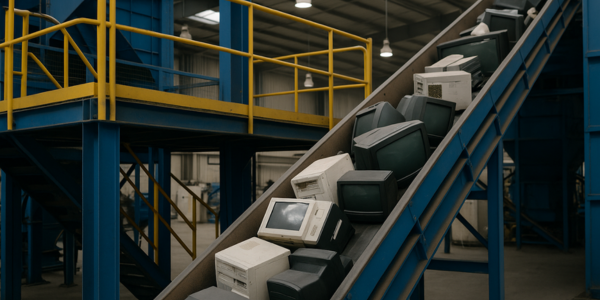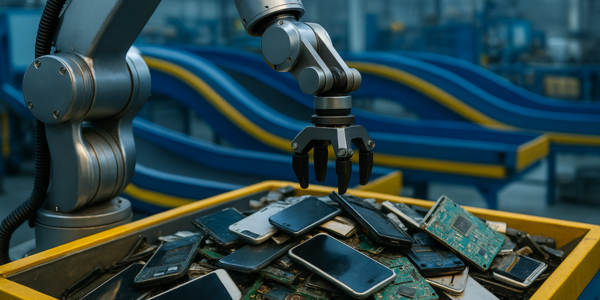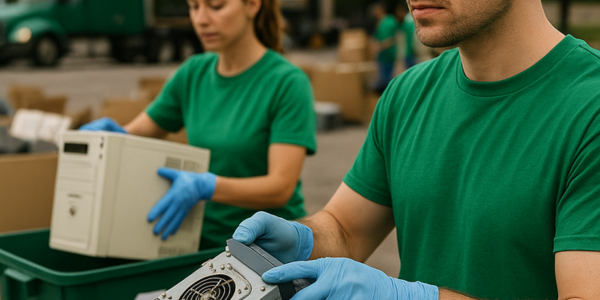How Corporate Leaders Can Drive E-Waste Management and Environmental Responsibility
As environmental challenges related to e-waste become more urgent, industries, governments, and consumers are intensifying efforts to enhance e-waste management. Technological innovations, stronger regulations, corporate sustainability goals, and heightened consumer awareness are driving the shift toward sustainable practices. Here’s how these factors are shaping the future of e-waste management:
Technological Innovations

Environmental concerns are catalyzing significant advancements in e-waste recycling technologies, making processes more efficient, sustainable, and eco-friendly. These innovations are transforming how electronic waste is managed, ensuring that valuable materials are recovered while minimizing environmental harm.
AI-Driven Sorting
Artificial intelligence is revolutionizing the recycling industry by introducing automated sorting systems that markedly improve accuracy and efficiency.
-
Precise Material Identification: AI-powered systems can analyse and identify electronic components with unparalleled accuracy, ensuring the effective separation of materials like gold, silver, and copper from non-recyclable waste.
-
Increased Efficiency: Automated sorting dramatically accelerates the recycling process, allowing facilities to process large volumes of e-waste while reducing labour costs and human error.
-
Environmental Impact Minimization: By isolating hazardous substances such as lead and mercury with precision, AI reduces the risk of these toxins contaminating the environment.
Advanced Recycling Technologies

The complexity of modern electronic devices presents distinct challenges in recycling. However, innovative technologies are addressing these challenges by introducing advanced and sustainable methods.
-
Hydrometallurgical Processes: Using aqueous solutions, these methods dissolve and extract metals like gold, platinum, and copper with high efficiency. Unlike traditional methods, hydrometallurgical processes are less energy-intensive and generate fewer harmful byproducts, making them environmentally friendly.
-
Pyrometallurgical Processes: By employing controlled high-temperature techniques, this method efficiently melts components to recover metals. Recent advancements have optimized energy use, reducing carbon emissions and the environmental footprint of the process.
-
Cryogenic Recycling: This innovative technique involves freezing e-waste to extremely low temperatures, making it brittle and easier to dismantle. It is particularly effective for separating intricate components in printed circuit boards, offering a safer and cleaner alternative to conventional methods.
Eco-Friendly Recycling Processes
New eco-friendly recycling methods aim to minimise the environmental impact of handling hazardous e-waste components.
-
Bioleaching: By harnessing naturally occurring microorganisms, bioleaching dissolves metals from e-waste without using harmful chemicals or high-energy processes. It’s a sustainable and scalable solution for recovering metals like copper and gold.
-
Green Chemistry Solutions: Eco-friendly solvents and reagents, such as ionic liquids and supercritical fluids, are being developed to recover valuable materials safely and efficiently. These methods eliminate the toxic emissions associated with traditional recycling practices.
-
Closed-Loop Systems: Innovations in recycling are moving toward circular processes where materials are continuously reused, reducing the need for raw material extraction and minimising waste.
Stronger Regulations
Governments worldwide are imposing stricter e-waste management regulations to address the growing environmental concern. These measures aim to promote responsible disposal and recycling practices.
-
Extended Producer Responsibility (EPR): Governments around the world are implementing stricter regulations to address the growing e-waste crisis and ensure proper disposal practices.
-
Global Agreements: International collaborations, such as the Basel Convention, aim to control the transboundary movement of hazardous e-waste, preventing illegal dumping in developing countries. These agreements encourage nations to adopt uniform standards for e-waste management.
Corporate Sustainability Goals
Recognising the environmental and social impacts of e-waste, corporations are integrating sustainability into their core business strategies.
-
Recycling Programs: Tech giants like Apple and Samsung have introduced recycling initiatives, offering customers the opportunity to trade in old devices for proper disposal or refurbishment.
-
Commitments to Sustainability: Companies are pledging to reduce their carbon footprints by designing electronics that are easier to recycle and contain fewer hazardous materials. These efforts not only minimise environmental harm but also appeal to environmentally conscious consumers.
-
Refurbishment Initiatives: Businesses are extending the life of electronic devices by refurbishing and reselling them. This reduces e-waste generation while providing affordable tech options to consumers.
Increased Consumer Awareness

Consumer behaviour is playing a pivotal role in the demand for better e-waste management solutions.
-
Shift Toward Sustainability: With growing awareness about the environmental consequences of improper e-waste disposal, more consumers are prioritizing sustainable options when purchasing electronics.
-
Demand for Recycling Programs: People are increasingly participating in recycling initiatives and advocating for accessible e-waste collection points. This shift is pressuring governments and businesses to improve recycling infrastructure.
-
Preference for Eco-Friendly Electronics: Consumers are leaning towards devices designed with sustainability in mind, such as energy-efficient products and gadgets made from recycled materials.
The Way Forward
Environmental concerns are not just fuelling awareness; they are driving action. From cutting-edge technologies and robust policies to corporate initiatives and consumer demand, the collective effort to manage e-waste sustainably is gaining momentum. As these solutions evolve, they hold the promise of transforming how we produce, use, and dispose of electronics, paving the way for a greener, more sustainable future.
It’s time for all stakeholders, governments, businesses, and individuals to join forces and champion e-waste management practices that protect our planet for generations to come.